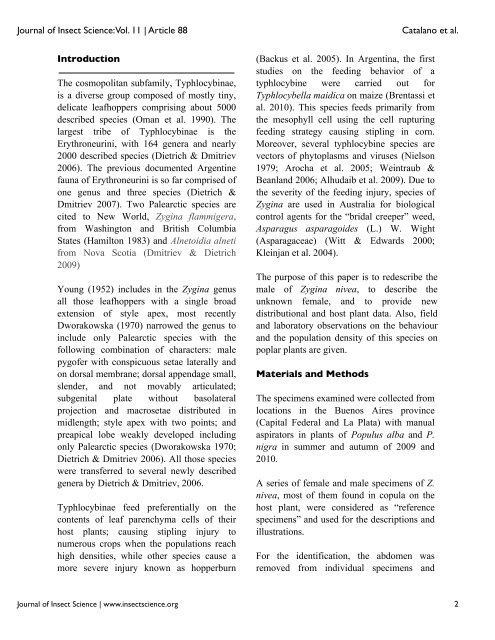Download free PDF - Journal of Insect Science
Download free PDF - Journal of Insect Science
Download free PDF - Journal of Insect Science
You also want an ePaper? Increase the reach of your titles
YUMPU automatically turns print PDFs into web optimized ePapers that Google loves.
<strong>Journal</strong> <strong>of</strong> <strong>Insect</strong> <strong>Science</strong>: Vol. 11 | Article 88<br />
Catalano et al.<br />
Introduction<br />
The cosmopolitan subfamily, Typhlocybinae,<br />
is a diverse group composed <strong>of</strong> mostly tiny,<br />
delicate leafhoppers comprising about 5000<br />
described species (Oman et al. 1990). The<br />
largest tribe <strong>of</strong> Typhlocybinae is the<br />
Erythroneurini, with 164 genera and nearly<br />
2000 described species (Dietrich & Dmitriev<br />
2006). The previous documented Argentine<br />
fauna <strong>of</strong> Erythroneurini is so far comprised <strong>of</strong><br />
one genus and three species (Dietrich &<br />
Dmitriev 2007). Two Palearctic species are<br />
cited to New World, Zygina flammigera,<br />
from Washington and British Columbia<br />
States (Hamilton 1983) and Alnetoidia alneti<br />
from Nova Scotia (Dmitriev & Dietrich<br />
2009)<br />
Young (1952) includes in the Zygina genus<br />
all those leafhoppers with a single broad<br />
extension <strong>of</strong> style apex, most recently<br />
Dworakowska (1970) narrowed the genus to<br />
include only Palearctic species with the<br />
following combination <strong>of</strong> characters: male<br />
pyg<strong>of</strong>er with conspicuous setae laterally and<br />
on dorsal membrane; dorsal appendage small,<br />
slender, and not movably articulated;<br />
subgenital plate without basolateral<br />
projection and macrosetae distributed in<br />
midlength; style apex with two points; and<br />
preapical lobe weakly developed including<br />
only Palearctic species (Dworakowska 1970;<br />
Dietrich & Dmitriev 2006). All those species<br />
were transferred to several newly described<br />
genera by Dietrich & Dmitriev, 2006.<br />
Typhlocybinae feed preferentially on the<br />
contents <strong>of</strong> leaf parenchyma cells <strong>of</strong> their<br />
host plants; causing stipling injury to<br />
numerous crops when the populations reach<br />
high densities, while other species cause a<br />
more severe injury known as hopperburn<br />
(Backus et al. 2005). In Argentina, the first<br />
studies on the feeding behavior <strong>of</strong> a<br />
typhlocybine were carried out for<br />
Typhlocybella maidica on maize (Brentassi et<br />
al. 2010). This species feeds primarily from<br />
the mesophyll cell using the cell rupturing<br />
feeding strategy causing stipling in corn.<br />
Moreover, several typhlocybine species are<br />
vectors <strong>of</strong> phytoplasms and viruses (Nielson<br />
1979; Arocha et al. 2005; Weintraub &<br />
Beanland 2006; Alhudaib et al. 2009). Due to<br />
the severity <strong>of</strong> the feeding injury, species <strong>of</strong><br />
Zygina are used in Australia for biological<br />
control agents for the “bridal creeper” weed,<br />
Asparagus asparagoides (L.) W. Wight<br />
(Asparagaceae) (Witt & Edwards 2000;<br />
Kleinjan et al. 2004).<br />
The purpose <strong>of</strong> this paper is to redescribe the<br />
male <strong>of</strong> Zygina nivea, to describe the<br />
unknown female, and to provide new<br />
distributional and host plant data. Also, field<br />
and laboratory observations on the behaviour<br />
and the population density <strong>of</strong> this species on<br />
poplar plants are given.<br />
Materials and Methods<br />
The specimens examined were collected from<br />
locations in the Buenos Aires province<br />
(Capital Federal and La Plata) with manual<br />
aspirators in plants <strong>of</strong> Populus alba and P.<br />
nigra in summer and autumn <strong>of</strong> 2009 and<br />
2010.<br />
A series <strong>of</strong> female and male specimens <strong>of</strong> Z.<br />
nivea, most <strong>of</strong> them found in copula on the<br />
host plant, were considered as “reference<br />
specimens” and used for the descriptions and<br />
illustrations.<br />
For the identification, the abdomen was<br />
removed from individual specimens and<br />
<strong>Journal</strong> <strong>of</strong> <strong>Insect</strong> <strong>Science</strong> | www.insectscience.org 2
















